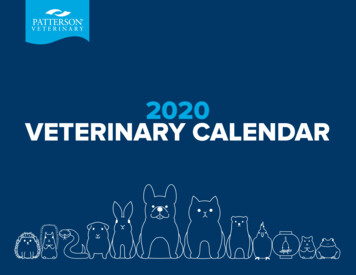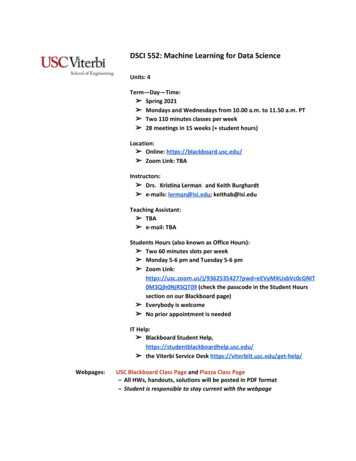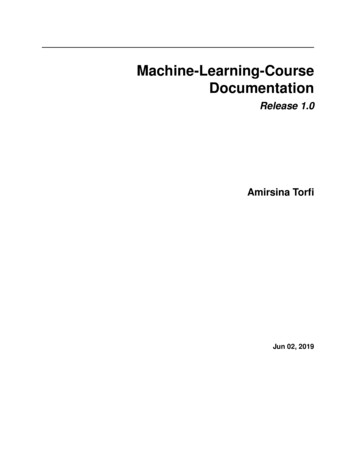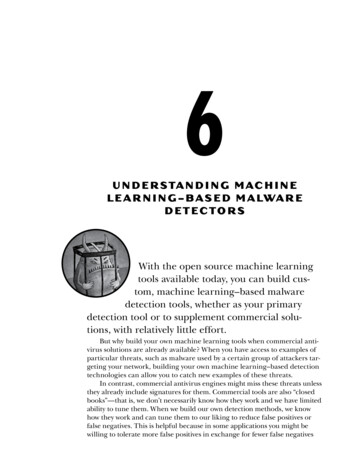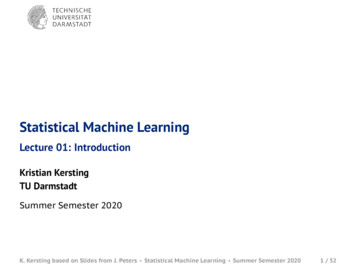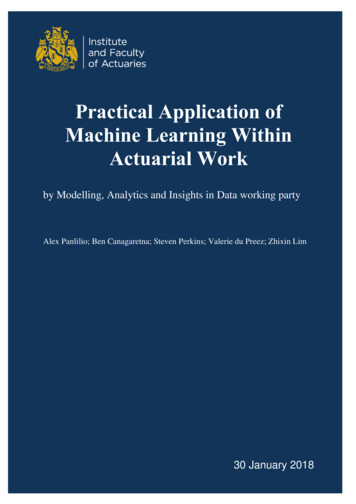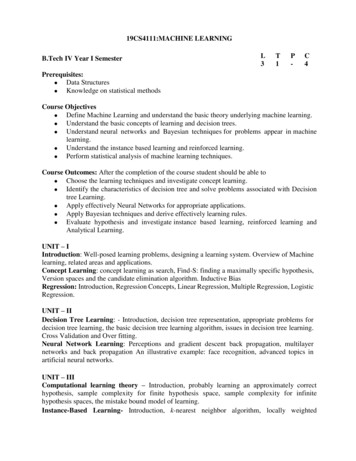
Transcription
19CS4111:MACHINE LEARNINGB.Tech IV Year I SemesterL3T1P-C4Prerequisites: Data Structures Knowledge on statistical methodsCourse Objectives Define Machine Learning and understand the basic theory underlying machine learning. Understand the basic concepts of learning and decision trees. Understand neural networks and Bayesian techniques for problems appear in machinelearning. Understand the instance based learning and reinforced learning. Perform statistical analysis of machine learning techniques.Course Outcomes: After the completion of the course student should be able to Choose the learning techniques and investigate concept learning. Identify the characteristics of decision tree and solve problems associated with Decisiontree Learning. Apply effectively Neural Networks for appropriate applications. Apply Bayesian techniques and derive effectively learning rules. Evaluate hypothesis and investigate instance based learning, reinforced learning andAnalytical Learning.UNIT – IIntroduction: Well-posed learning problems, designing a learning system. Overview of Machinelearning, related areas and applications.Concept Learning: concept learning as search, Find-S: finding a maximally specific hypothesis,Version spaces and the candidate elimination algorithm. Inductive BiasRegression: Introduction, Regression Concepts, Linear Regression, Multiple Regression, LogisticRegression.UNIT – IIDecision Tree Learning: - Introduction, decision tree representation, appropriate problems fordecision tree learning, the basic decision tree learning algorithm, issues in decision tree learning.Cross Validation and Over fitting.Neural Network Learning: Perceptions and gradient descent back propagation, multilayernetworks and back propagation An illustrative example: face recognition, advanced topics inartificial neural networks.UNIT – IIIComputational learning theory – Introduction, probably learning an approximately correcthypothesis, sample complexity for finite hypothesis space, sample complexity for infinitehypothesis spaces, the mistake bound model of learning.Instance-Based Learning- Introduction, k-nearest neighbor algorithm, locally weighted
regression, case-based reasoning, remarks on lazy and eager learning.UNIT - IVGenetic Algorithms: Motivation, Genetic algorithms, an illustrative example, hypothesis spacesearch, genetic programming, models of evolution and learning.Learning Sets of Rules – Introduction, sequential covering algorithms, learning rule sets:summary, learning First-Order rules, learning sets of First-Order rules: FOIL, Induction as inverteddeduction, inverting resolution.UNIT – VReinforcement Learning – Introduction, the learning task, Q–learning, non-deterministic, rewardsand actions, temporal difference learning, generalizing from examples, relationship to dynamicprogramming.Analytical Learning- Introduction, learning with perfect domain theories: PROLOG-EBG,remarks on explanation-based learning, explanation-based learning of search control knowledge.TEXT BOOKS:1. Tom. M Mitchell, Machine Learning, McGraw Hill, 1997.2. Trevor has tie, Robert Tibshirani & Jerome Friedman. The Elements of Statically Learning,Springer Verlag, 2001.REFERENCES:1. Machine Learning Methods in the Environmental Sciences, Neural Networks, William WHsieh, Cambridge UnivPress.2. Richard o. Duda, Peter E. Hart and David G. Stork, pattern classification, John Wiley &SonsInc.,2001.3. Chris Bishop, Neural Networks for Pattern Recognition, Oxford University Press, 1995.
19CS4112:DATA MININGB.Tech IV Year I SemesterL3T-P-C3Pre-Requisites: A course on “Database Management Systems” Knowledge of probability and statisticsCourse Objectives To Understand the concepts of Data Mining To Familiarize with frequent patterns, associations, and correlations. To describes methods for data classification and prediction. To understand the data–clustering approaches. To understand various types of data stores such as spatial, textual, multimedia, streams.Course Outcomes: After the completion of the course student should be able to Ability to understand the types of the data to be mined and present a generalclassification of Tasks and primitives to integrate a data mining system. Apply preprocessing methods for any given raw data, Extract interesting patterns fromlarge amounts of data. Discover the role played by data mining in various fields. Choose and employ suitable data mining algorithms to build analytical applications Evaluate the accuracy of supervised and unsupervised models and algorithms.UNIT - IData Mining: Data–Types of Data–, Data Mining Functionalities– Interestingness Patterns–Classification of Data Mining systems– Data mining Task primitives –Integration of Data miningsystem with a Data warehouse–Major issues in Data Mining–Data Preprocessing- Data Cleaning,Data Integration and Transformation Data Reduction, Discretization and Concept HierarchyGeneration, measures of similarity and dissimilarity-basics.UNIT - IIAssociation Rule Mining: Mining Frequent Patterns–Associations and correlations – MiningMethods – Mining various kinds of Association Rules– Correlation Analysis– Constraint basedAssociation mining. Graph Pattern Mining, Sequential Pattern Mining.UNIT - IIIClassification and Prediction: Basic concepts, Decision tree induction, Bayesian classification,Naive Bayes Classification, classification by Back propagation, Support vector machines, Lazylearners, other classification methods, Prediction.UNIT - IVClustering and Applications: Cluster analysis–Types of Data in Cluster Analysis–Categorizationof Major Clustering Methods– Partitioning Methods, Hierarchical Methods– Density–BasedMethods, Grid–Based Methods, Outlier Analysis.
UNIT - VAdvanced Concepts: Basic concepts in mining data streams–Mining Time–series data––Miningsequence patterns in Transactional databases– Mining Object– Spatial– Multimedia–Text and Webdata – Spatial Data mining– Multimedia Data mining–Text Mining– Mining the World Wide Web.TEXT BOOKS:1. Data Mining – Concepts and Techniques – Jiawei Han & Micheline Kamber, 3rd EditionElsevier.2. Data Mining Introductory and Advanced topics – Margaret H Dunham, PEA.REFERENCES:1. Ian H. Witten and Eibe Frank, Data Mining: Practical Machine Learning Tools andTechniques (Second Edition), Morgan Kaufmann, 2005.
19CS4171: SECURITY ANALYSIS(Professional Elective - III)T P C3Prerequisites: Should have basic knowledge of computer networks and information security.B.Tech IV Year I SemesterL3Course Objectives: To introduce the information security terminology, technology and its applications To introduce data leakage threats and its solutions To give guidelines for implementing security policies in the organization To make familiar with the roles and responsibilities in security domain To make familiar with information security vulnerabilities and threatsCourse Outcomes: After the completion of the course student should be able to Identify various security attacks and issues Classify types of data leakage threats and prevention techniques. List the information security policies and procedures Differentiate various information security management roles and responsibilities Identify various threats, vulnerabilities and appropriate vulnerability management andassessment solutionsUNIT-IInformation Security Management: Information Security Overview, Threats and Attack Vectors,Types of Attacks, Common Vulnerabilities, and Exposures (CVE), Security Attacks, Fundamentalsof Information Security, Computer Security Concerns, Information Security Measures etc.UNIT-IIFundamentals of Information Security: Key Elements of Networks, Logical Elements ofNetwork, Critical Information Characteristics, Information States etc.Data Leakage: What is Data Leakage and statistics, Data Leakage Threats, Reducing the Risk ofData Loss, Key Performance Indicators (KPI), and Database Security etc.UNIT-IIIInformation Security Policies, Procedures, and Audits: Information Security Policies necessitykey elements & characteristics, Security Policy Implementation, Configuration, Security StandardsGuidelines & Frameworks etc.UNIT-IVInformation Security Management – Roles and Responsibilities: Security Roles &Responsibilities, Accountability, Roles, and Responsibilities of Information Security Management,team-responding to emergency situation-risk analysis process etc.UNIT-VInformation Security Vulnerabilities-Threats and vulnerabilities, human and computer basedsocial engineering, social media countermeasures, vulnerability management-vulnerability
scanning, testing, threat management, remediation etc. Vulnerability assessment, classification,vulnerability assessment phases, characteristics of a good vulnerability assessment solutions,vulnerability assessment reports-tools, information security risk assessment, risk treatment, residualrisk, risk acceptance, risk management feedback Loops etc.TEXT BOOKS:1. Information Security Management – A student’s Hand Book – NASCOMM2. Management of Information Security by Michael E. Whitman and Herbert J. Mattord3. Assessing Information Security (strategies, tactics, logic and framework) by A Vladimirov,K.Gavrilenko, and A.Michajlowski.REFERENCES:1. Information Security Management Handbook, Fourth Edition, Volume I-TIPTONHAROLD F.2. tandards/iso27001.htm23. Rev1/SP800-55-rev1.pdf4. CISSP (ISC) 2 Certified Information Systems Security Professional Official Study GuidePaperback –Import,8 Oct 2015 byJames M.Stewart (Author), Mikehapple(Author), Darril Gibson (Author)5. The Art of Computer Virus Research and Defense by Peter Szor.
19CS4172: CLOUD COMPUTING(Professional Elective - III)B.Tech IV Year I SemesterL3T-P-C3Pre-requisites: A course on “Computer Networks” A course on “Operating Systems”Course Objectives: To explain the evolving computer model called cloud computing. To Understand the current trend and basics of cloud computing. To introduce the various levels of services that can be achieved by cloud. To describe the security aspects in cloud. To Learn cloud enabling technologies and its applications.Course Outcomes: After the completion of the course student should be able to Understand various service delivery models of a cloud computing architecture. Understand the virtualization and cloud computing concepts. Understand cloud computing architecture and managing cloud infrastructure and itsapplications. Acquire knowledge on cloud service models. Acquire knowledge on cloud service providers.UNIT-IComputing Paradigms: High-Performance Computing, Parallel Computing, DistributedComputing, Cluster Computing, Grid Computing, Cloud Computing, Bio computing, MobileComputing, Quantum Computing, Optical Computing, Nano Computing.UNIT-IICloud Computing Fundamentals: Motivation for Cloud Computing, The Need for CloudComputing, Defining Cloud Computing, Definition of Cloud Computing, Cloud Computing Is aService, Cloud Computing Is a Platform, Principles of Cloud computing, Five EssentialCharacteristics, and Four Cloud Deployment Models.UNIT-IIICloud Computing Architecture and Management: Cloud Architecture, Layer, Anatomy of theCloud, Network Connectivity in Cloud Computing, Applications, on the Cloud, Managing theCloud, Managing the Cloud Infrastructure Managing the Cloud Application, Migrating Applicationto Cloud, Phases of Cloud Migration Approaches for Cloud Migration.UNIT-IVCloud Service Models: Infrastructure as a Service, Characteristics of IaaS. Suitability of IaaS, Prosand Cons of IaaS, Summary of IaaS Providers, Platform as a Service, Characteristics of PaaS,
Suitability of PaaS, Pros and Cons of PaaS, Summary of PaaS Providers, Software as a Service,Characteristics of SaaS, Suitability of SaaS, Pros and Cons of SaaS, Summary of SaaS Providers,Other Cloud Service ModelsUNIT-VCloud Service Providers: EMC, EMC IT, Captiva Cloud Toolkit, Google, Cloud Platform, CloudStorage, Google Cloud Connect, Google Cloud Print, Google App Engine, Amazon Web Services,Amazon Elastic Compute Cloud, Amazon Simple Storage Service, Amazon Simple Queue,Service, Microsoft, Windows Azure, Microsoft Assessment and Planning Toolkit, SharePoint,IBM, Cloud Models, IBM Smart Cloud, SAP Labs, SAP HANA Cloud Platform, VirtualizationServices Provided by SAP, Sales force, Sales Cloud, Service Cloud: Knowledge as a Service, Rackspace, VMware, Manjrasoft, Aneka Platform.TEXT BOOKS:1. Essentials of cloud Computing: K. Chandrasekhran, CRC press, 2014.REFERENCES:1. Cloud Computing: Principles and Paradigms by Rajkumar Buyya, James Broberg andAndrzej, M.Goscinski, Wiley, 2011.2. Distributed and Cloud Computing, Kai Hwang, Geoffery C. Fox, Jack J. Dongarra, Elsevier,2012.3. Cloud Security and Privacy: An EnterprisePerspective on Risks and Compliance, TimMather, SubraKumaraswamy, ShahedLatif, O’Reilly, SPD, rp2011.
19CS4173: AD-HOC & SENSOR NETWORKS(Professional Elective - III)B.Tech IV Year I SemesterL3T-P-C3Prerequisites A course on “Computer Networks” A course on “Mobile Computing”Course Objectives To understand the concepts of sensor networks. To understand the MAC and transport protocols for ad hoc networks. To understand the security of sensor networks. To understand the applications of adhoc and sensor networks. To Understand the transport layer and security issues possible in Ad hoc and Sensornetworks.Course Outcomes: After the completion of the course student should be able to Understand the state-of-the-art research in the emerging subject of Ad Hoc and WirelessSensor Networks. Solve the issues in real-time application development based on ASN. Conduct further research in the domain of ASN. Understand the transport layer and security issues possible in Ad hoc and sensornetworks. Acquire knowledge on upper layer issues of WSN.UNIT - IIntroduction to Ad Hoc Networks - Characteristics of MANETs, Applications of MANETs andchallenges of MANETs. Routing in MANETs - Criteria for classification, Taxonomy of MANETrouting algorithms, Topology based routing algorithms-Proactive: DSDV; Reactive: DSR, AODV;Hybrid: ZRP; Position-based routing algorithms-Location Services-DREAM, Quorum-based;Forwarding Strategies: Greedy Packet, Restricted Directional Flooding-DREAM, LAR.UNIT - IIData Transmission - Broadcast Storm Problem, Rebroadcasting Schemes-Simple-flooding,Probability-based Methods, and Area-based Methods, Neighbor Knowledge-based: SBA,Multipoint Relaying, and AHBP.Multicasting: Tree-based: AMRIS, MAODV; Mesh-based: ODMRP, CAMP; Hybrid: AMRoute,MCEDAR.UNIT - IIIGeocasting: Data-transmission Oriented-LBM; Route Creation Oriented-GeoTORA, MGR.TCPover Ad Hoc TCP protocol overview, TCP and MANETs, Solutions for TCP over Ad hoc.UNIT - IVBasics of Wireless, Sensors and Lower Layer Issues: Applications, Classification of sensor
networks, Architecture of sensor network, Physical layer, MAC layer, Link layer, Routing Layer.UNIT - VUpper Layer Issues of WSN: Transport layer, High-level application layer support, Adapting to theinherent dynamic nature of WSNs, Sensor Networks and mobile robots.TEXT BOOKS:1. Ad Hoc and Sensor Networks – Theory and Applications, Carlos Corderio Dharma P.Aggarwal, World Scientific Publications, March 2006, ISBN – 981–256–681–3.2. Wireless Sensor Networks: An Information Processing Approach, Feng Zhao, LeonidasGuibas, Eseview Science, ISBN – 978-1-55860-914-3 (Morgan Kauffman).REFERENCES:1. Carlos De Morais Cordeiro, Dharma Prakash Agrawal, ―Ad Hoc and Sensor Networks:Theory and Applications (2nd Edition)‖, World Scientific Publishing, 2011.
19CS4174: DIGITAL FORENSICS(Professional Elective - III)B.Tech IV Year I SemesterPre-Requisites: Computer Networks ProtocolsL3T-P-C3Course Objective To understand the basic digital forensics and techniques for conducting the forensicexamination on different digital devices. To impart an introduction to the need of computer forensics. To understand how to examine digital evidences such as the data acquisition, identificationanalysis. To study the tools and tactics associated with cyber forensics. To analyze and validate computer forensics data.Course Outcomes: After the completion of the course student should be able to Know how to apply forensic analysis tools to recover important evidence for identifyingcomputer crime. Be well-trained as next-generation computer crime investigators. Knowledge on Forensics acquisition tools. Knowledge on Processing crimes and Scenes. Knowledge on validating and testing forensic software’s.UNIT -IComputer Forensics Fundamentals, Benefits of Forensics, Computer Crimes, Computer ForensicsEvidence and Courts, Legal Concerns and Private issues.UNIT- IIUnderstanding Computing Investigations – Procedure for corporate High-Tech investigations,understanding data recovery work station and software, conducting and investigations.UNIT-IIIData acquisition- understanding storage formats and digital evidence, determining the bestacquisition method, acquisition tools, validating data acquisitions, performing RAID dataacquisitions, remote network acquisition tools, other forensics acquisitions tools.UNIT-IVProcessing crimes and incident scenes, securing a computer incident or crime, seizing digitalevidence at scene, storing digital evidence, obtaining digital hash, reviewing case.UNIT-VCurrent computer forensics tools- software, hardware tools, validating and testing forensicsoftware, addressing data-hiding techniques, performing remote acquisitions, e-mail investigations-
investigating email crime and violations, understanding e-mail servers, specialized e-mail forensicstoolTEXT BOOKS:1. Warren G. Kruse II and Jay G. Heiser, “Computer Forensics: Incident Response Essentials”,Addison Wesley, 2002.2. Nelson, B, Phillips, a, Enfinger, F, Stuart, C., “Guide to Computer Forensics andInvestigations, 2nd ed., Thomson Course Technology, 2006, ISBN: 0-619-21706-5.REFERENCES:1. Vacca, J, Computer Forensics, Computer Crime Scene Investigation, 2nd Ed, Charles RiverMedia, 2005, ISBN: 1-58450-389.
19CS4175: SOFTWARE PROCESS & PROJECT MANAGEMENT(Professional Elective - IV)B.Tech IV Year I SemesterL3T-P-C3Course Objectives A basic knowledge of software project management principles. The ability to come up with a project schedule and assign resources. Choose an appropriate project development methodology (e.g. waterfall, spiral.) Identify project risks, monitor and track project deadlines. The capability to work in a team environment and be aware of different modes ofcommunications.Course Outcomes: After the completion of the course student should be able to Identify and describe how different project contexts will impact upon all aspects of asoftware development project. Identify and describe the key phases of project management and the key skillsassociated with each. Determine an appropriate project management approach through an evaluation of thebusiness onalprojectmanagementapproaches. Demonstrate through application, knowledge of the key project management skills, suchas product and work break-down structure, schedule; governance including progressreporting, risk and quality management. As part of a small team research and produce a concise piece of writing suitable forpresentation to senior management.UNIT-IConventional Software Management: The waterfall model, conventional software Managementperformance. Overview of Project Planning – Stepwise Project Planning.Improving Software Economics: Reducing Software product size, improving software processes,improving team effectiveness, improving automation, Achieving required quality, peer inspections.UNIT –IIThe old way and the new way: The principles of conventional software Engineering, principlesof modern software management, transitioning to an iterative process.Life cycle phases: Engineering and production stages, Inception, Elaboration, Construction,Transition phases.Artifacts of the process: The artifact sets, Management artifacts, Engineering artifacts,programmatic artifacts.UNIT –IIIWork Flows of the process: Software process workflows, Iteration workflows.Checkpoints of the process: Major milestones, Minor Milestones, Periodic statusAssessments.Iterative Process Planning: Work breakdown structures, planning guidelines, cost and schedule
estimating, Iteration planning process, Pragmatic planning.UNIT–IVProcess Automation: Automation Building blocks.Project Control and Process instrumentation: These Vencor Metrics, Management indicators,quality indicators, life cycle expectations, pragmatic Software Metrics, Metrics automation.Tailoring the Process: Process discriminates.UNIT–VProject Organizations and Responsibilities:Line-of-Business Organizations, Understanding Behavior – Organizational BehaviorFuture Software Project Management: Modern Project Profiles, Next generation Softwareeconomics, modern process transitions.Case Study: The command Center Processing and Display system-Replacement (CCPDS-R).TEXT BOOKS:1. Software Project Management, Walker Royce: Pearson Education, 2005.REFERENCES:1. Software Project Management, Bob Hughes and Mike Cotterell: Tata McGraw-Hill Edition.2. Software Project Management, Joel Henry, Pearson Education.3. Software Project Management in practice, Pankaj Jalote, Pearson Education.2
19CS4176: SCRIPTING LANGUAGES(Professional Elective - IV)B.Tech IV Year I SemesterPrerequisites: A course on “Computer Programming and Data Structures” A course on “Object Oriented Programming Concepts” A course on “Web Technologies”L3T-P-C3Course Objectives Introduces Ruby, Ruby on Rails, RubyGems and RubyTk scripting languages. Introduces scripting languages such as Extending Ruby and Embedding a Ruby Interpreter. Introduces PERL and Scripting. Introduces Advanced PERL to create Internet applications. Introduces TCL, Tk and Perl-Tk.Course Outcomes: After the completion of the course student should be able to Understand how to comprehend the differences between Ruby, Ruby on Rails and RubyTkand Designing CGI scripts using Ruby and Web. Understand and Extend the Ruby and Embedding a Ruby Interpreter. Create and run scripts using PERL and able to translate from Perl/Tk to Ruby. Create Internet ware applications by Advanced Perl. Acquire programming skills in TCL, Tk and Perl-Tk.UNIT - IIntroduction: Ruby, Rails, Difference between Ruby and Ruby on Rails, The structure andExecution of Ruby Programs, Package Management with RUBYGEMS, Ruby and web: WritingCGI scripts, cookies, Choice of Web servers, SOAP and web services, RubyTk – Simple TkApplication, widgets, Binding events, Canvas, scrolling.UNIT - IIExtending Ruby: Ruby Objects in C, the Jukebox extension, Memory allocation, Ruby TypeSystem, Embedding Ruby to Other Languages, Embedding a Ruby InterpreterUNIT - IIIIntroduction to PERL and Scripting:Scripts and Programs, Origin of Scripting, Scripting Today, Characteristics of mes and Values, Variables, Scalar Expressions, Control Structures, arrays, list, has, strings,pattern and regular expressions, subroutines, Translating from Perl/Tk to Ruby.
UNIT - IVAdvanced perl:Finer points of looping, pack and unpack, file system, eval, data structures, packages, modules,objects, interfacing to the operating system, Creating Internet ware applications, Dirty HandsInternet Programming, security Issues.UNIT - VTCL: TCL Structure, syntax, Variables and Data in TCL, Control Flow, Data Structures,input/output, procedures, strings, patterns, files, Advance TCL- eval, source, exec and up levelcommands, Name spaces, trapping errors, event driven programs, making applications internetaware, Nuts and Bolts Internet Programming, Security Issues, C Interface. Tk Tk-Visual Tool Kits,Fundamental Concepts of Tk, Tk by example, Events and Binding, Perl-Tk.TEXT BOOKS:1. The World of Scripting Languages, David Barron, Wiley Publications.2. Ruby Programming language by David Flanagan and Yukihiro MatsumotoO’Reilly3. “Programming Ruby” The Pramatic Programmers guide by Dabve Thomas Second editionREFERENCES:1. Open Source Web Development with LAMP using Linux Apache, MySQL, Perl and PHP,J. Lee and B. Ware (Addison Wesley) PearsonEducation.2. Perl by Example, E. Quigley, Pearson Education.3. Programming Perl, Larry Wall, T. Christiansen and J. Orwant, O’Reilly, SPD.4. Tcl and the Tk Tool kit, Ousterhout, PearsonEducation.5. Perl Power, J. P. Flynt, CengageLearning.
19CS4177: INTERNET OF THINGS(Professional Elective - IV)B.Tech IV Year I SemesterL3T-P-Course Objectives To introduce the terminology, technology and its applications To introduce the concept of M2M (machine to machine) with necessary protocols To introduce the Python Scripting Language which is used in many IoT devices To introduce the Raspberry PI platform, that is widely used in IoT applications To introduce the implementation of web-based services on IoT devicesC3Course Outcomes: After the completion of the course student should be able to Interpret the impact and challenges posed by IoT networks leading to new architecturalmodels. Compare and contrast the deployment of smart objects and the technologies to connectthem to network. Appraise the role of IoT protocols for efficient network communication. Elaborate the need for Data Analytics and Security in IoT. Illustrate different sensor technologies for sensing real world entities and identify theapplications of IoT in Industry.UNIT - IIntroduction to Internet of Things –Definition and Characteristics of IoT, Physical Design of IoT –IoT Protocols, IoT communication models, IoT Communication APIs IoT enabled Technologies –Wireless Sensor Networks, Cloud Computing, Big data analytics, Communication protocols,Embedded Systems, IoT Levels and Templates Domain Specific IoTs – Home, City, Environment,Energy, Retail, Logistics, Agriculture, Industry, health and LifestyleUNIT - IIIoT and M2M – Software defined networks, network function virtualization, difference betweenSDN and NFV for IoT Basics of IoT System Management with NETCOZF, YANG- NETCONF,YANG, SNMP NETOPEERUNIT - IIIIntroduction to Python - Language features of Python, Data types, data structures, Control of flow,functions, modules, packaging, file handling, data/time operations, classes, Exception handlingPython packages - JSON, XML, HTTPLib, URLLib, SMTPLibUNIT - IVIoT Physical Devices and Endpoints - Introduction to Raspberry PI-Interfaces (serial, SPI, I2C)Programming – Python program with Raspberry PI with focus of interfacing external gadgets,controlling output, reading input from pins.
UNIT – VIoT Physical Servers and Cloud Offerings – Introduction to Cloud Storage models andcommunication APIs Web server – Web server for IoT, Cloud for IoT, Python web applicationframework designing a RESTful web APITEXT BOOKS:1. Internet of Things - A Hands-on Approach, Arshdeep Bahga and Vijay Madisetti,Universities Press, 2015, ISBN: 97881737195472. Getting Started with Raspberry Pi, Matt Richardson & Shawn Wallace, O'Reilly (SPD),2014, ISBN: 9789350239759REFERENCES:1. The Internet of Things in the Cloud: A Middleware Perspective - Honbo Zhou – CRC Press–20122. Architecting the Internet of Things - Dieter Uckelmann; Mark Harrison; FlorianMichahelles-(Eds.) – Springer – 20113. Networks, Crowds, and Markets: Reasoning About a Highly Connected World - DavidEasley and Jon Kleinberg, Cambridge University Press - 20104. The Internet of Things: Applications to the Smart Grid and Building Automation by –Olivier Hersent, Omar Elloumi and David Boswarthick - Wiley -20125. Olivier Hersent, David Boswarthick, Omar Elloumi , “The Internet of Things – Keyapplications and Protocols”, Wiley, 2012
19CS4178–HUMAN COMPUTER INTERACTION(Professional Elective - IV)B.Tech IV Year I SemesterL3T-P-C3Course Objectives To gain an overview of human computer interaction (HCI). To understand the basic HCI concepts and various design process, standards andguidelines. To Perform implementation support and evaluation of their design To become familiar with the vocabulary associated with sensory and cognitive systemsas relevant to task performance by humans. To learn various cognitive models models.Course Outcomes: After the completion of the course student should be able to Apply HCI and principles to interaction design. Design certain tools for blind or PH people. Understand user interface design in general and alternatives to traditional “keyboard andmouse” computing. Implement HCI in software process. Apply models from cognitive psychology to predicting user performance in various HCItasks and recognize the limits of human performance as they apply to computeroperation.UNIT-IIntroduction: Importance of user Interface – definition, importance of good design. Benefits ofgood design. A brief history of Screen design.The graphical user interface – popularity of graphics, the concept of direct manipulation,graphical system, Characteristics, Web user–Interface popularity, characteristics-Principles of userinterface.UNIT-IIDesign process – Human interaction with computers, importance of human characteristics humanconsideration, Human interaction speeds and understanding business junctions.Screen Designing: Design goals–Screen planning and purpose, organizing screen elements,ordering of screen data and content – screen navigation and flow – Visually pleasingComposition – amount of information – focus and emphasis – presentation information simply andmeaningfully – information retrieval on web– statistical graphics– Technological consideration ininterface design.UNIT-IIIWindows–New and Navigation schemes selection of window, selection of devices based andscreen-based controls. Components – text and messages, Icons and increases – M
19CS4111:MACHINE LEARNING B.Tech IV Year I Semester Prerequisites: Data Structures Knowledge on statistical methods Course Objectives Define Machine Learning and understand the basic theory underlying machine learning. Understand the basic concepts of learning and decision trees. Understand neural networks and Bayesian techniques for problems appear in machine



